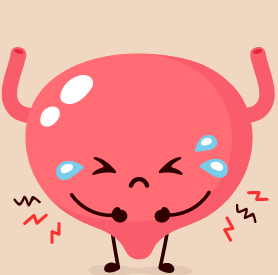Today’s blog is going to be an all encompassing discussion about bladder health. We will get a chance to answer those burning questions of:
What’s urgency?
How many times am I supposed to go to the bathroom?
What does incontinence mean?

You might be experiencing a bladder related pelvic floor dysfunction if you experience symptoms such as urinary leakage/incontinence, dribbling after your urinate, urgency or frequency, or difficulty urinating.
So let’s talk about the bladder now. The bladder has a special type of muscle called the detrusor. It’s special in the fact that it allows for stretching and contracting. In the stretching (the filling up of the bladder with urine) it begins to send signals to your brain notifying you that it may be time to “go to the bathroom” soon! Pelvic floor therapists will often refer to these signals as “urges”. Usually you will get a light, medium or severe level of urgency to get to the restroom! Then when it’s time to eliminate the urine, the detrusor muscle will contract thus emptying the bladder.
If you want to talk about evidence-based norms then here we go!
Normal Bathroom Trips to Urinate in 24 hours
- Average of 5-8 times per 24 Hours
- 0-1 Times at Night
- Average amount of urine to be voided is 200-250 mL
- In your 20’s average times/trips to urinate: 8.2 times
- In your 30’s average times/trips to urinate: 6.9 times
- First sensation of filling is around 3-8 oz
- First desire to go to the bathroom is around 6-8 oz
- Strongest desire to go to the bathroom is around 11-18 oz
- Thank you to Al Afraa et al., 2012, and Herman & Wallace for the statistics.
Research-based Norms in Regards to Bladder Urges from Mahfouz et al., 2012
- First sensation of filling is around 3-8 oz
- First desire to go to the bathroom is around 6-8 oz
- Strongest desire to go to the bathroom is around 11-18 oz
Many factors can affect these urges such as lifestyle, nutrition, hydration, breast-feeding, altitude, bladder irritants, physical injuries, or family habits can ALL affect your bladder health & urge tendencies.
For an example if you are breast-feeding and are intaking more water than you normally would, then you might feel the urge to go sooner or more frequently than you did before… However on the same note, if you are breastfeeding frequently and struggle with your baby wanting to sleep on you, maybe you have stopped going to the bathroom when you get those strong urges because you are desperate for sleep?
The coin can be flipped both ways, and what I mean by that is going to the bathroom too often can create an urgency or frequency problem but not going enough can also create a bladder and pelvic floor dysfunction.
If you are interested in finding out what your bladder habits look like then you need to download the Belle Therapy + Wellness Bladder Diary
There are some commonly known and talked about bladder irritants. Now what does that mean exactly? There are certain types of drinks and foods that naturally irritate the bladder, or aka can cause frequent urination, itchiness, burning while urinating, or even sometimes cause bladder spasms.
Common Food & Drinks that can cause Bladder Irritation:
- Alcohol
- Coffee
- Chocolate
- Spicy Foods
- Certain Acidic or Citrus based Foods: fruit juices, lemon/lime, grapefruit, oranges..
- Related to the above citrus based foods- look for ingredients in your drinks that are sodium citrate, or citric acid.
Now I am not saying you need to stop having your wine and chocolate night, but I am saying that you can try avoiding these foods for 1-2 weeks and see if your symptoms improve! You might be surprised 😊
If you feel like you are going to the bathroom the appropriate times per day, not struggling with losing control of your bladder, and feel like it’s easy to go and have no problems whatsoever 👏 then good for you! Unfortunately in today’s society it is more common to have a problem, than to be healthy.
Common Myths Debunked 🤯
1. Incontinence is not normal in…. pregnancy, postpartum, peri-menopausal, or with age.
2. You should never go the bathroom “just in case”.
3. Kegels DO NOT fix every pelvic floor issue!!
We will be diving into more specifics with bladder related pelvic floor dysfunctions! So if you found this blog helpful in any way, or have a lingering question then please drop a comment below 👇!! Please be sure to check back every Monday for the newest blog 😊